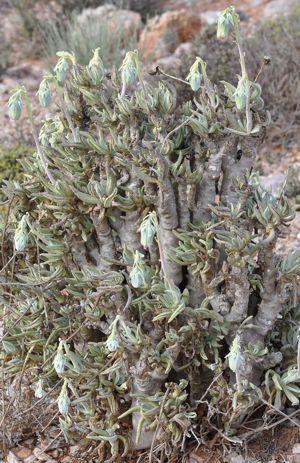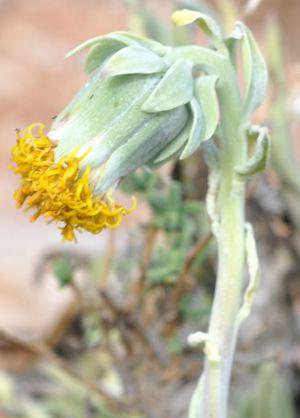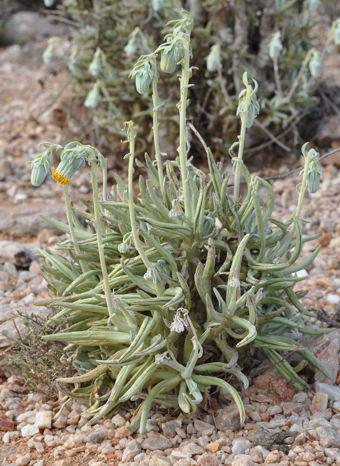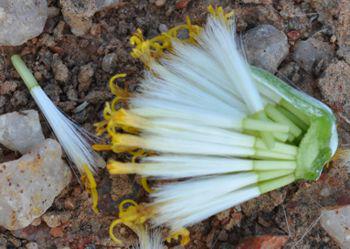Kleinia cephalophora
Kleinia cephalophora Compton
Family: Asteraceae
Common names: blazing glory, mountain fire, cliff kleinia
Introduction
Kleinia cephalophora is a striking succulent-stemmed perennial, with blue-green leaves and large, beautiful, nodding flowerheads.

Description
Description
This is an evergreen, succulent-stemmed, perennial shrub, up to 400 mm tall.
Leaves lanceolate, 30–100 × 10–15 mm, slightly succulent, blue-green, with margins strongly recurved.
Flowerheads terminal, large, ± 30 mm in diameter, 35 mm , solitary, nodding, but becoming suberect when in full flower; florets bright yellow, sometimes becoming orange. Involucre obconic; bracts united halfway. Pappus present, bristles 15–20 mm long, white. Flowers May–August.

Conservation Status
Status
Kleinia cephalophora is currently listed as LC (Least Concern) in the Red List of South African plants.
Distribution and habitat
Distribution description
The species occurs in southern Namibia, the Richtersveld to around Springbok, and extends into Bushmanland and eastern Namaqualand in the Northern Cape. It is found on rocky slopes at an elevation of 600 to 800 m (Snijman 2013).

Derivation of name and historical aspects
History
Kleinia is a genus of ± 40 succulent shrublets, mostly from tropical Africa, and also in India and Thailand. The genus is recognized by the succulent stems, with tuberous roots, discoid capitula and style arms with conical to elongated terminal appendages (Nordenstam 2007). Kleinia cephalophora was described by Compton in 1949, based on the exceptionally large size of the pedunculate capitula that is distinct from other species of Kleinia.
Ecology
Ecology
On the apex of the fruit is a tuft of barbellate hairs called a pappus, which as in many other Asteraceae can assist with wind dispersal. Pollination of this species has not been studied but the sweet scent of the flowers suggest that insect pollination takes place.

Uses
Use
No cultural or medicinal uses have been recorded for Kleinia cephalophora as yet. However, some sources warn that the consumption of the plant by humans or animals may cause minor toxicity and that coming into contact with the sap from bruised or broken plant parts, could lead to skin irritation (Almost Eden).
Growing Kleinia cephalophora
Grow
The species prefers rocky, well-drained substrates and so is an ideal candidate for the back of a rockery. Flowering commences in autumn (May–August). Coming from arid regions with a predominantly winter rainfall, this species needs to be protected from summer rainfall and heavy frost, and should be given full or partial sun. Propagation is easy from cuttings which root freely or otherwise from seeds sown in autumn.
References
- Almost Eden URL: http://almostedenplants.com/shopping/html/p10214MountainFireSenecio.htm.htm Accessed on: 11 May 2015
- Compton, R.H. 1949. Plantae Novae Africanae. Journal of South African Botany VXV: 104, 105.
- Kleinia cephalophora Compton. National Assessment: Red List of South African plants version 2014.1. Accessed on 2015/05/15
- Nordenstam, B. 2007. Tribe Senecioneae. In J.W. Kadereit & C. Jeffrey, Kubitzki’s The families and genera of vascular plants Vol. 8. Springer, Heidelberg, pp. 208–24.
- Snijman, D.A. (ed.). 2013. Plants of the Greater Cape Floristic Region 2: The Extra Cape Flora. Strelitzia 30. South African National Biodiversity Institute, Pretoria.
- Vanijajiva, O. Pornpongrungrueng, P. & Pongamornkul, W. 2014.Kleinia grandiflora (Asteraceae: Senecioneae), a species and genus newly discovered in Thailand. Phytotaxa VCLIX(I):17–22.
Credits
Jaimie Poovan & Luvo Magoswana
Compton Herbarium
June 2015
Plant Attributes:
Plant Type: Shrub, Succulent
SA Distribution: Northern Cape
Soil type: Sandy, Loam
Flowering season: Autumn, Winter
PH: Acid, Neutral
Flower colour: Yellow, Orange
Aspect: Full Sun, Afternoon Sun (Semi Shade)
Gardening skill: Easy
Special Features:
Horticultural zones










Rate this article
Article well written and informative
Rate this plant
Is this an interesting plant?
Login to add your Comment
Back to topNot registered yet? Click here to register.